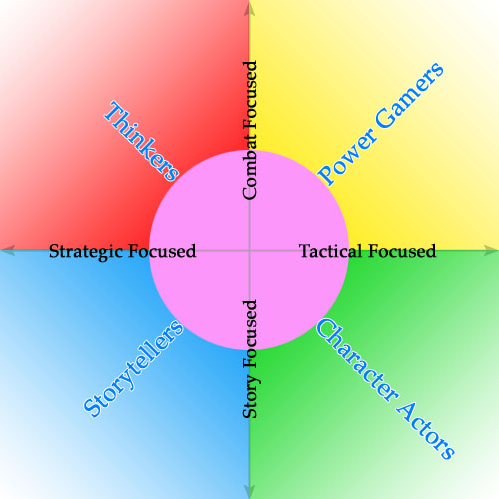What elements are present in an ideal roleplaying game session? The answer will vary of course, depending on the particular game and (more importantly) the interests of those playing the game. Given that many groups have players with different interests, it’s important to understand different player motivations.
Based on this industry study of roleplayers, there are four main categories of players:
- Thinkers are players who enjoy games with a Strategic/Combat Focus. These players enjoy min-maxing a character and finding every conceivable advantage available in the system, even if the min-maxing is illogical. These players want to solve puzzles and track facts and clues.
- Power Gamers are players who enjoy games with a Tactical/Combat Focus. These players enjoy short, intense gaming experiences and don’t mind character death or care much about storyline implications of their character’s action.
- Character Actors are players who enjoy a Tactical/Story Focus. They like the act of theater (using voice, posture and props). They focus on character’s motivations, ethics, and knowledge.
- Storytellers are players enjoy a Strategic/Story Focus. They enjoy the logical progression of the story’s narrative looking for a beginning, a middle and end to the narrative.
There is a fifth type of player, a “basic roleplayer”, who enjoys strategy, tactics, combat and story in rough equilibrium.
It seems to me that a perfect RPG game, if you have players with each of these motivations, will cater to all these play styles to ensure player groups with mixed playstyles will allow each player to have an experience in each session doing what they like best.
So what does this mean?
In my opinion, it means that each adventure session will contain:
- Puzzles, facts and clues.
- Set-piece battles and other complex conflicts to allow strategy and tactics (may involve a battlemat or boss-fight)
- Intense gaming experiences with drama, rising tension, and excitement.
- Visuals, props, and handouts.
- Integrating character motivations, ethics, and knowledge into the drama.
- Move a meta-plot / campaign arc forward (even if only a little).
- Structure sessions or campaigns to have a story with beginning, a middle and end.
- Player-drive narrative control with sandbox-style roleplaying allowing players to go anywhere and do anything.
The design team at Wizards of the Coast speak about three pillars of the roleplaying experience they are focusing on for the next iteration of the world’s oldest RPG, namely:
- Combat
- Exploration
- Interaction
Mapping this to playstyle elements, you see these aspects at play:
- Combat (Set-piece battles )
- Exploration (Puzzles, Visuals, props, and handouts)
- Interaction (Story, character motivations, ethics, and knowledge; meta-plot / campaign arc, sandbox-style Player-drive narrative control)
Refactoring this into a design checklist for GM’s, target using some or all of the following to create game sessions with appeal to multiple player styles:
- Storyline (Scripting a story or backstory with beginning, middle and end)
- Mystery (Giving puzzles with clues)
- Props (Showing visuals and handouts)
- Character Tie-ins (Integrating character backstory, old enemies, or character edges, flaws or hindrances into the story)
- Meta-plot (Moving the campaign arc forward)
- Boss Fight (Providing set-piece battle with terrain elements and possibly multiple enemy combatants or groups)
- Sandbox (Allowing for player-drive narrative control)
In future posts I’ll have some concrete suggestions about using a structured design and elements such as a GM’s phase and Player’s phase to allow you to hit each of these game elements in each and every session.




Recent Comments